Equinox establishes new SUV standard at Chevrolet
Filed under: Weekly test drives, Autos
By John Gilbert
Interesting times, in the SUV universe known as General Motors, and more specifically Chevrolet. While other GM brands always have tried to specialize — Cadillac with all-out luxury, Buick with “near-luxury,” etc. — the strategy at Chevy has been to try to build all manner of vehicle for all customers.
Chevy’s Suburban started the whole SUV thing, back in the 1930s, and it not only still exists but is thriving as the giant of the segment. Slightly reduced in size is the Tahoe, which has grown to be so big that if you didn’t know the Suburban was still out there, you’d think the Tahoe was the industry giant.
Scaling down from there, we have the more midsize Traverse, then the still more compact Equinox, and finally the (subcompact?) Trax. As a dedicated small-as-you-can-stand advocate, I like the Trax, although I have always found the Equinox to be a pleasant compromise, being built on an automobile platform and gaining much more economy and efficiency than its larger siblings, but somehow managing to provide plenty of interior room, and good fuel economy — particularly when measured against the large-and-getting-larger Suburban.
The Traverse also works, although it’s just enough larger that it seems to require the optional V6 over the 4-cylinder engine. The Equinox seems to get along just fine with the 4.
For 2018, Chevrolet has taken a bold step and completely redesigned the Equinox — making it still more compact. The Equinox is now 4.7 inches shorter and its wheelbase is 5.2 inches shorter, which is quite a lot, and reduces the difference between the Trax and Equinox, while increasing the margin between Equinox and Traverse. The test Equinox 183.1 inches long, with a wheelbase of 107.3. It’s 65.3 inches tall and 72.6 wide.
Such a size reduction is indeed bold when you consider that the Equinox is Chevrolet’s second-largest-selling vehicle, trailing only the Silverado pickup! Read more
Mercedes E400 Coupe covers all sporty, luxury needs
Filed under: Weekly test drives, Autos
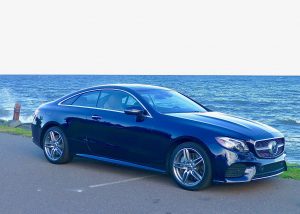
Mercedes has advanced technology filling its midsize E-Class sedans to the point that a sporty, 4-seat Coupe was the only way to turn.
By John Gilbert
You drive someplace in your Mercedes-Benz, and no matter which model — 2-door, 4-door, convertible, or SUV — you enjoy every second you’re behind the wheel. The feeling of refinement, of corraling all that power and channeling it into a luxurious body, is something you feel every foot of your drive.
When you park the Mercedes and climb out, the enjoyment and appreciation doesn’t end. Especially if you happen to be driving a 2018 Mercedes-Benz E400 4Matic Coupe. In the case of th E400 Coupe, it might be that your appreciation is heightened when you climb out and can take a few steps away and then look back at your prize.
A week with a test E400 4Matic Coupe wasn’t really fair. The car color was called Lunar Blue Metallic, and it was such a rich, dark blue that it defied normal definition. The first time my wife, Joan, walked out to the car with me, she got close and then said, “Oh. I thought it was black.” True, in subdued light, it looked like it might be a rich, black, but if you’re a blue fanatic, as I am, it might be the richest blue on the planet. Read more
Genesis G80 splits off to lift Hyundai’s image
Filed under: Weekly test drives, Autos
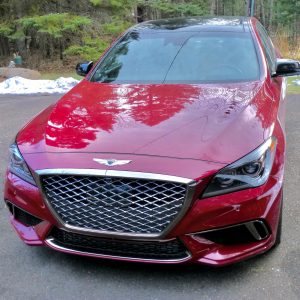
The Genesis model is now Hyundai’s separate luxury-sporty sedan line, amd the 2018 G80 AWD is a winner for all seasons.
By John Gilbert
When South Korea burst upon the elite level of auto design and technology, it was the 2011 Sonata that led the charge, with over-the-top contours, high-strength steel construction, and an advanced direct-injected 2.4-liter 4-cylinder engine with a lighter and more efficient in-house 6-speed transmission.
After that breakthrough in the midsize class, Hyundai went on to upgrade every engine and design to high-tech advancements. It also quickly added a larger and more luxurious Genesis sedan, which began life with a V8 engine that carried all of Hyundai’s self-taught technology. It won Car of the Year awards and the engine won Ward’s engine design awards.
My intention here is to renew acquaintances with the mainstream Genesis G80, a true combination of sportiness and luxury in a solid, strong-performing sedan. But before we get to the details of this beautifully redesigned G80, it still is important to scan Hyundai’s rapid expansion in the industry.
Hyundai added still another upscale super-luxury car called the Equus, above the Genesis, to present a full arsenal of vehicles, from tiny Accent, to compact Elantra, sporty — if oddball — Veloster coupe, the all-new Ioniq hybrid-or-electric compact, then to the Sonata, Azera, Genesis and Equus. On the side, its SUV group had the compact Tucson, and the larger Santa Fe, among others. All this time, Hyuundai had just taken on Kia as an affiliate, then partner, building parallel models and sharing in Hyundai’s breakthrough technology. The attempt now is to differentiate between Hyundai and Kia models, making Kia’s the sportier and Hyundai’s the more mainstream or luxurious.
As the 2017 model year blends into the 2018s, Hyundai is attempting to spin Genesis off into its own line, not unlike Acura for Honda, Infiniti for Nissan and Lexus for Toytoa, although far less prominent than those Japanese competitors. Hyundai eliminated the Equus moniker, condensing the car into the top-level Genesis model as the G90. The Genesis G70 is on the more compact, sporty side. In fact, the G70 is the Hyundai version of the much-promoted new Kia Stinger, which has been voted one of three finalists for North American Car of the Year.
Finally, I hear you say, we’re getting to today’s topic, which is the Genesis G80 — the Genesis model numerically between the sportiest G70 and the most luxurious G90.
Price range for the Genesis models is high-$30,000 for the G70, somewhere in the $50,000 range for the G80, and into the $70,000 level for the G90. Far beyond the mid-$20,000 to mid-$30,000 range of the Sonata.
With all of that stored away, the G80 is a superb sedan, living up to the rave reviews a colleague of mine has issued after buying a G80 a couple of years ago. It is, however, significantly redone for 2018, and the test model was, officially, the G80 AWD 3.3T Sport.
My test vehicle was not just a sporty or luxury sedan, but a stunning combination of every asset a car-buyer might want, need, or dream about. It handles with sporty flatness in turns, and is rock-solid over all manner of roadway, and you can dial it back from the sporty end of the adaptive Sport suspension to soften the ride. Read more
Land Rover? Range Rover? HSE Td6 is a prize
Filed under: Weekly test drives, Autos
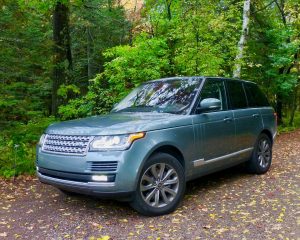
Always being refined and updated, the new Land Rover Range Rover HSE now comes with a powerful,. high-mileage 3.0 turbo-diesel.
By John Gilbert
My standard assessment of Land Rover vehicles is that they would be the SUV of choice if you wanted to drive from wherever you are to Hudson Bay, without using any roads.
Driving a new 2017 Land Rover Range Rover HSE Td6 for a week, including a highway trip from Duluth, Minnesota, to Chicago, reinforced my previous and long-standing assessment. With an exclamation point!
Some Land Rovers are Land Rovers, and others are Range Rovers, usually the higher-end models. The one I drove was the latest iteration of the standard “Land Rover Range Rover” and it broke new ground by being powered by a 3.0-liter V6 Turbodiesel engine, with a strong 254 horsepower, and an overwhelming 443 foot-pounds of torque, all harnessed through an 8-speed automatic transmission.
While diversifying its model range, you can now start with the Land Rover Discovery Sport, starting at $40,000; the stylish Land Rover Range Rover Evoque, starting at $43,000; the Land Rover Discovery starting at around $50,000; the new Land Rover Range Rover Velar, starting at $50,000; the Lan6d Rover Range Rover Sport, starting at $67,000; up to the Land Rover Range Rover, ranging from $87,000 to $201,000.
An intriguing array, and I want to drive all of them, never mind that I have no idea how they differentiate between a Range Rover and a Land Rover. The topic for the day will do, particularly now that I know my Land Rover Range Rover can run from $87,000 to over $200,000. The sticker price in the test vehicle showed a total of $95,645, and it was so well-equipped that I can’t imagine what all might be added to double its sticker.
In this specific model, you can choose from a 3.0-liter gas V6 in two forms, both supercharged, or the 3.0 Turbodiesel, or the top-line 5.0-liter V8, supercharged to 550 horsepower and 502 foot-pounds of torque. Compared to that, 254 horsepower sounds puny, but it’s the 443 foot-pounds of torque that matters, when you are pulling away from a start, scaling a hill, or towing something hefty.
The 3.0 Turbodiesel was quiet, almost unnervingly quiet, and when you told anyone that it was a diesel, they listened closely and doubted you. The comparative silence is a good thing, recalling the loud, smoky, clattering pre-clean diesels of past years.
But this one was equally impressive on the freeway, or climbing the steep avenues of Duluth, which is one of the stiffest road-test disciplines imaginable. When you head up Lake Avenue, knowing you need to climb eight blocks of about 20-degree grade, you instinctively step on the accelerator. In the new Range Rover Turbodiesel, such a move allows you to imagine what space travel might be like at launch-time. The vehicle nearly flies from the start with a strong surge of power and no hesitation. That’s what 443 foot-pounds of torque will do for even a hefty, 2-ton-plus SUV. Read more
Land Cruiser, Highlander offer wide SUV span
Filed under: Weekly test drives, Autos
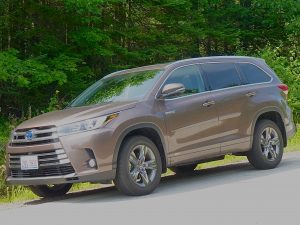
Toyota’s wide range of SUVs includes the high-tech new Highlander Hybrid that combines size with high-20s for fuel economy.
By John Gilbert
Let’s say that you intend to buy an SUV, and you need a large one, and you are a dedicated Toyota loyalist. You have looked at and rejected the Highlander, which is pretty big, and you are intent on going right to the top — the Land Cruiser.
Once you’ve decided to make the investment in the Land Cruiser, you know you are susceptible to one of those lucrative option lists, where you have to fight temptation to greatly increase the already large sticker price. So you ask what’s available. Herein is the biggest surprise of selecting a Land Cruiser.
There are no options.
Your only choice is the exterior color, and the interior color. That means once you’ve accepted the sticker price of $85,520, you can’t add any options. At that price, the Land Cruiser comes equipped, and we mean fully equipped. As in, loaded.
There isn’t even an optional engine available, which means you are forced to “choose” the 5.7-liter dual-overhead-camshaft V8, turning out 381 horsepower and 401 foot-pounds of torque, with full-time 4-wheel drive and a Torsen locking limited-slip center differential, plus its kinetic dynamic suspension, and multi-terrain selection that includes assets such as hill-start assist, off-road turn assist, and even crawl control, which makes the Land Cruiser sound more like some sort of Jeep.
Of course, it does carry the maximum pride of Toyota when it comes to off-road capability, dating back decades to when it was the company’s only off-road vehicle. It was built rugged then, and it continues to be over-engineered for normal family-hauling duty.
For those who might have thought large SUVs had gone the way of dinosaurs, and thought that maybe Chevrolet Suburbans were the only huge SUVs left, think again. The Land Cruiser did get a pretty good makeover a year ago, and the new model carries on, already equipped with a new 8-speed automatic transmission, the full Toyota Safety Series-P active safety equipment, and the ability to tow 8,100 pounds of trailer.
For its great length and roomy 3-row seating, the Land Cruiser drives lighter than seems possible. The suspension makes for a comfortable ride over all surfaces, which includes off-roading and also the challenging state of most urban streets and roadways.
Safety equipment includes lane-departure alert, pre-collision warning, radar cruise control, cross-traffic alert, blind-spot alert, trailer sway control, plus LED headlilghts, daytime running lights, and foglights. And, while not a safety feature, it also has the Entune JBL Audio upgrade. So are those two gigantic 11-inch screens affixed to the backs of the front bucket seats, with wireless headsets for monitoring your own DVDs if you’re a rear-seat occupant. Those back in the third row just have to suffer from long-distance viewing. Read more


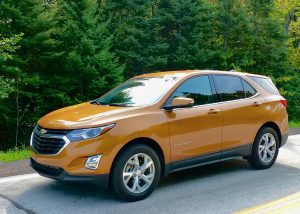
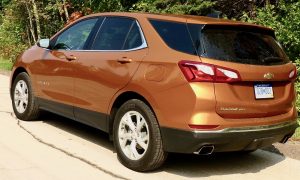

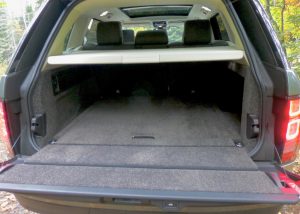
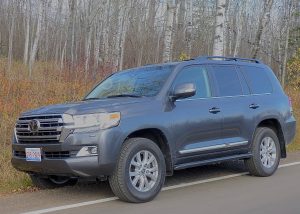

 John Gilbert is a lifetime Minnesotan and career journalist, specializing in cars and sports during and since spending 30 years at the Minneapolis Tribune, now the Star Tribune. More recently, he has continued translating the high-tech world of autos and sharing his passionate insights as a freelance writer/photographer/broadcaster. A member of the prestigious North American Car and Truck of the Year jury since 1993. John can be heard Monday-Friday from 9-11am on 610 KDAL(www.kdal610.com) on the "John Gilbert Show," and writes a column in the Duluth Reader.
John Gilbert is a lifetime Minnesotan and career journalist, specializing in cars and sports during and since spending 30 years at the Minneapolis Tribune, now the Star Tribune. More recently, he has continued translating the high-tech world of autos and sharing his passionate insights as a freelance writer/photographer/broadcaster. A member of the prestigious North American Car and Truck of the Year jury since 1993. John can be heard Monday-Friday from 9-11am on 610 KDAL(www.kdal610.com) on the "John Gilbert Show," and writes a column in the Duluth Reader.